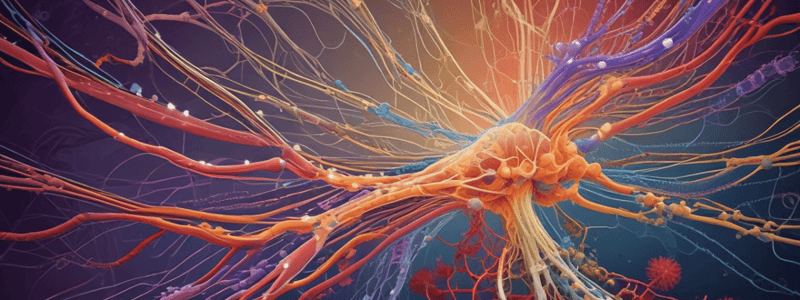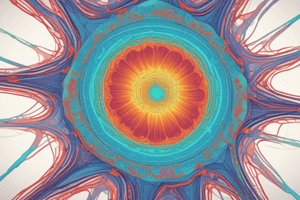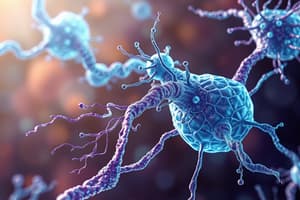Podcast
Questions and Answers
What is the fundamental unit of an intermediate filament?
What is the fundamental unit of an intermediate filament?
- Monomer
- Filament
- Tetramer (correct)
- Helical dimer
What is the result of mutations in keratins?
What is the result of mutations in keratins?
- Amyotrophic lateral sclerosis (ALS)
- Neurodegenerative disease
- Skin cancer
- Epidermolysis bullosa simplex (EBS) (correct)
What is the structure composed of 13 parallel protofilaments?
What is the structure composed of 13 parallel protofilaments?
- Intermediate filament
- Microfilament
- Microtubule-associated protein
- Microtubule (correct)
What is the function of plectin?
What is the function of plectin?
What is the characteristic of subunit exchange in intermediate filaments?
What is the characteristic of subunit exchange in intermediate filaments?
What is the result of abnormal expression of neurofilamins?
What is the result of abnormal expression of neurofilamins?
What is the function of thymosin β4 in actin binding proteins?
What is the function of thymosin β4 in actin binding proteins?
What is the role of villin in microvilli?
What is the role of villin in microvilli?
What is the function of gelsolin in actin filaments?
What is the function of gelsolin in actin filaments?
What is the role of myosin in non-muscle cells?
What is the role of myosin in non-muscle cells?
What is the function of lamellipodia in cell movement?
What is the function of lamellipodia in cell movement?
What is the function of intermediate filaments (IF) in epithelial cells?
What is the function of intermediate filaments (IF) in epithelial cells?
What is unique about lamins compared to other intermediate filaments?
What is unique about lamins compared to other intermediate filaments?
What is the diameter of intermediate filaments?
What is the diameter of intermediate filaments?
What is the approximate diameter of microtubules in the cytoskeleton?
What is the approximate diameter of microtubules in the cytoskeleton?
What is the primary function of actin microfilaments in muscle cells?
What is the primary function of actin microfilaments in muscle cells?
Which of the following is NOT a function of the cytoskeleton?
Which of the following is NOT a function of the cytoskeleton?
What is the name of the globular protein that monomers polymerize to form actin microfilaments?
What is the name of the globular protein that monomers polymerize to form actin microfilaments?
What is the process involved in the polymerization of actin microfilaments?
What is the process involved in the polymerization of actin microfilaments?
What is the orientation of monomers in an actin microfilament?
What is the orientation of monomers in an actin microfilament?
What is the percentage of cellular protein that actin microfilaments comprise?
What is the percentage of cellular protein that actin microfilaments comprise?
What is the name of the intermediate filaments' diameter?
What is the name of the intermediate filaments' diameter?
What is the main cause of autosomal dominant polycystic kidney disease?
What is the main cause of autosomal dominant polycystic kidney disease?
What is the effect of colchicine on microtubules?
What is the effect of colchicine on microtubules?
What is the function of hemidesmosomes?
What is the function of hemidesmosomes?
What is the result of defective cilia-mediated movement of growth factors in the embryo?
What is the result of defective cilia-mediated movement of growth factors in the embryo?
What is the function of desmosomes?
What is the function of desmosomes?
What is the effect of taxol on microtubules?
What is the effect of taxol on microtubules?
What is the typical diameter of a microtubule?
What is the typical diameter of a microtubule?
Which motor protein moves cargo towards the (-) end of a microtubule?
Which motor protein moves cargo towards the (-) end of a microtubule?
What is the primary function of the centrioles in the centrosome?
What is the primary function of the centrioles in the centrosome?
What is the main function of the mitotic spindle?
What is the main function of the mitotic spindle?
Which type of cilia is involved in sound detection in the inner ear?
Which type of cilia is involved in sound detection in the inner ear?
What is the role of the Basal Body in cilia?
What is the role of the Basal Body in cilia?
What is the function of GTP-bound monomers in microtubule assembly?
What is the function of GTP-bound monomers in microtubule assembly?
What is the function of the aster microtubules in the mitotic spindle?
What is the function of the aster microtubules in the mitotic spindle?
Flashcards are hidden until you start studying
Study Notes
Cytoskeleton
- A network of protein filaments in a cell with a range of functions, including:
- Connection with Extracellular Matrix (ECM)
- Maintaining cell shape
- Intracellular transport
- Cytokinesis
- Chromosome separation
- Cell movement
Composition of Cytoskeleton
- Actin microfilaments:
- Polymers of actin
- 7-9 nm diameter
- Intermediate filaments:
- Tissue-specific proteins
- 10 nm diameter
- Microtubules:
- Polymers of tubulin
- 25 nm diameter
Actin Microfilaments
- Monomer is a globular protein (G-actin) containing an ATP-binding domain
- G-actin polymerizes to microfilament (F-actin) via ATP hydrolysis
- Polymerization involves non-covalent interactions, with monomers in Head-to-Tail orientation
- Each microfilament has a (+) and (-) end, and monomers can be added at both ends
- Dynamic structure, with length dependent on relative rate of loss and gain of G-actin monomers
- Actin microfilaments are usually present as two tightly wound chains
- Comprise approximately 5% of cellular protein
Function of Actin
- Muscle contraction (covered in "Skeletal Muscle" lecture)
- Mechanical support (e.g., in microvilli)
- Maintaining cell shape
- Cell movement
Actin Binding Proteins
- G-actin binding proteins:
- Thymosin β4: inhibits polymerization
- Cross-linking proteins:
- Villin: parallel bundles in microvilli
- Filamin: joining at angles to create a mesh
- Severing:
- Gelsolin: cuts and binds (+) end; the other part depolymerizes – "gel to sol"
Contraction in Non-Muscle Cells
- Muscle myosin is also present in non-muscle cells
- Interaction between myosin and actin microfilaments allows movement, requiring ATP hydrolysis
- Movement within cells:
- Cytokinesis: ring of actin forms in the center of the cell, anchors to the plasma membrane, and myosin contraction constricts the cell
- Movement of cells:
- Lamellipodia-mediated cell movement across the extracellular matrix (ECM)
Intermediate Filaments (IF)
- Polymers of individual IF proteins, 10nm in diameter
- Different IF proteins in different cell types:
- Epithelial cells: keratin(s) for physical support and external structures
- Axons: neurofilamin(s) for structural arrangement of axons
- Universal (nuclear): lamins A, B, C for supporting nuclear structure
- Usually stable and not dynamic, except for lamins during mitosis
Formation of IF Polymer
-
- Intermediate filament protein (monomer)
-
- Helical dimer
-
- Two dimers combine to form a tetramer (the fundamental unit of the IF)
-
- Tetramers link in a staggered formation and end-to-end to form the filament
-
- Subunit exchange is slow but occurs throughout the length of the filament
Microtubules
- Tubulin monomer is a heterodimer of α-tubulin and β-tubulin
- Protofilament has a (-) and (+) end
- Monomers can be rapidly added and removed from both (+) and (-) ends
- 13 parallel protofilaments arranged in a hollow tube, approximately 25nm diameter
Microtubule-Organizing Centre (MTOC)
- Usually has one end attached to a MTOC
- One MTOC associated with the nucleus
- Microtubules "grow out" from MTOC until reaching the destination and then are stabilized
Function of Microtubules
- Dynamic scaffold
- Spindle for chromatid separation during mitosis
- Movement of cargo to specific locations in the cell
- Central internal support of cilia
- Stabilize structure of cells (e.g., platelets)
- Organize the structure of organelles (e.g., endoplasmic reticulum)
Mitotic Spindle
- Spindle consists of microtubules
- Spindle formation initiated from the centrosome (a type of Microtubule-Organizing Centre)
- Centrosomes contain a pair of centrioles
- Centrioles contain stable fused microtubules
- Centrosomes form at two poles of the cell
- Kinetochore microtubules attached to the centromere of the chromatid
- Aster microtubules attach the centrosome to the cell membrane
Cilia
- Membrane-bound hair-like extensions
- Microtubules are the central support
- MTOC is called Basal Body, located close to the membrane
- Microtubules facilitate the movement of components up and down within cilia
- All cells have a single primary cilium
- Disassembled during mitosis
- Specialized types:
- Stereocilia in the inner ear for sound detection
- Motile cilia in respiratory/lung ciliated epithelia for beating and moving fluid around
Studying That Suits You
Use AI to generate personalized quizzes and flashcards to suit your learning preferences.



